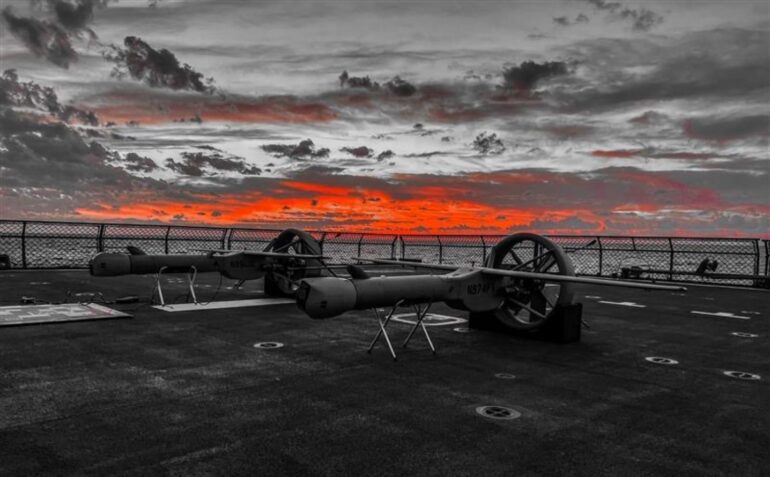TL;DR:
- Shield AI raises $200 million in Series F funding for its autonomous piloting software.
- The funding will support the integration of AI-based Hivemind software with third-party unmanned platforms.
- Hivemind demonstrates its capabilities by maneuvering fighter jets.
- Shield AI aims to expand AI pilot integration across various aircraft.
- Successful testing of AI piloting software for drone swarms.
- V-BAT Teams are expected on the battlefield in 2024.
- U.S. Innovative Technology Fund leads the funding round.
- Shield AI’s valuation reaches $2.7 billion.
Main AI News:
In a significant development for the autonomous drone industry, Shield AI has successfully raised an additional $200 million in venture capital as part of its Series F funding round. This funding will be instrumental in scaling and deploying the company’s cutting-edge autonomous piloting software on its V-BAT unmanned aircraft system (UAS). The primary objective is to empower these drones to operate seamlessly in coordinated teams, marking a pivotal advancement in drone technology.
Shield AI is poised to leverage this substantial capital infusion to expedite the integration of its artificial intelligence-driven Hivemind autonomous piloting software with third-party uncrewed platforms, further broadening its reach and impact in the unmanned aircraft sector. The company had earlier collaborated with Kratos Defense & Security Solutions to incorporate Hivemind into Kratos’ XQ-58 Valkyrie stealthy drone, enabling crewed and uncrewed jets to operate in tandem. Impressively, Hivemind demonstrated its capabilities by maneuvering an F-16 in air combat scenarios, solidifying its reputation as a leader in autonomous flight technology.
The relentless pursuit of excellence in flight testing continues at Shield AI, with the company proudly claiming to have accrued more autonomous maneuver flight hours with fighter jets than any other entity worldwide. While specific details about the aircraft earmarked for Hivemind installation remain undisclosed, Brandon Tseng, the co-founder and president of Shield AI, hinted at the company’s ambition to integrate AI pilots across a spectrum of aircraft OEMs in the group 5 space and select aerial platforms. Group 5 UAS, weighing over 1,320 pounds and operating above 18,000 feet, presents a significant opportunity for the implementation of autonomous technology. It’s worth noting that the V-BAT, classified as a group 3 drone and weighing 125 pounds, has demonstrated remarkable versatility in the realm of autonomous flight.
Recent milestones achieved by Shield AI include the successful completion of testing and demonstrations for its artificial intelligence piloting software designed for drone swarms. This advancement will enable the V-BAT to operate and execute missions autonomously, even in GPS and communications-denied environments, a feat that holds immense strategic value. Initially, the new software will be deployed in teams of four V-BATs, with the ambitious goal of doubling the number of drones annually.
Shield AI envisions V-BAT Teams taking the battlefield by storm in 2024. The company boldly asserts that, apart from lethal decision-making, V-BAT Teams are fully capable of autonomously executing missions from start to finish, eliminating the need for human operators or pilots.
Brandon Tseng shared insights into the company’s strategy, stating, “The new funding will enable us to scale V-BAT production to meet the surging demand for large V-BAT Teams. Simultaneously, we will continue refining autonomous behaviors through our fly-fix-fly process.” With V-BAT being a program of record, Shield AI’s UAS are actively deployed across 14 time zones, operating tirelessly around the clock. These drones boast vertical take-off and landing capabilities, coupled with efficient horizontal flight capabilities.
Highlighting the significance of Shield AI’s technology in the military landscape, Marine Corps Rotational Forces in Southeast Asia and Darwin have been conducting experiments with V-BAT systems. These experiments encompass various drones, communication equipment, and other systems, all contributing to the testing of distributed operations. Marine Corps Commandant Gen. Eric Smith emphasized the importance of rapidly sensing and comprehending the battlefield, underscoring the need for an efficient common operating picture and real-time data dissemination to joint and partner forces.
With the successful completion of this funding round, Shield AI’s valuation now stands at an impressive $2.7 billion. Leading the funding round is the U.S. Innovative Technology Fund, reflecting the strategic importance of Shield AI’s technology in the defense sector. As the U.S. Department of Defense seeks to bolster its arsenal of low-cost, attritable unmanned systems to counter China’s military expansion in the Western Pacific region, Shield AI’s innovations take on an even greater significance. The Replicator Initiative, aiming to procure thousands of such systems within the next 16 months, underscores the urgency of advancing AI-driven technologies in defense.
In conclusion, Thomas Tull, technology investor and chairman of USIT, highlighted the critical role of AI in meeting future defense technology needs. He stated, “The increasing number of military conflicts we have seen over the last 18 months, unfortunately, paints a sobering view of our future defense technology needs and the important role AI will play.” Shield AI continues to be at the forefront of innovation in this sector, spearheading the development of state-of-the-art AI pilots. It’s worth noting that USIT had previously invested in Shield AI during the Series E funding round, reflecting their confidence in the company’s vision and capabilities.
The latest Series F funding round saw participation from co-leader Riot Ventures, as well as returning contributors Disruptive and Snowpoint. Notable new investors, including Cathie Wood’s ARK Invest, have also joined in supporting Shield AI’s mission to revolutionize autonomous flight technology in the defense and commercial sectors.
Conclusion:
Shield AI’s successful funding round and ongoing advancements in autonomous piloting software signal a significant stride in the drone technology market. Their ability to integrate AI pilots across a wide range of aircraft and enable autonomous mission execution in challenging environments positions them as a leader in the sector. As the U.S. Department of Defense emphasizes the use of low-cost unmanned systems, Shield AI’s innovations align with the evolving needs of the defense and commercial markets, making them a key player to watch in the coming years.

